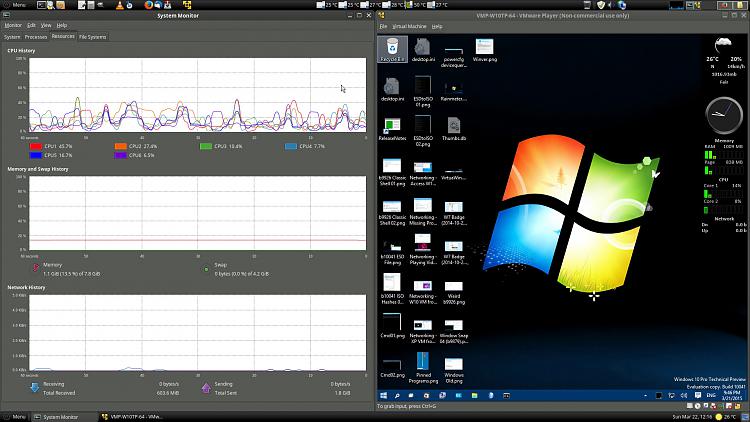New
#30
Windows 10 to make the Secure Boot alt-OS lock out a reality
-
-
New #31
-
New #32
Dated March 2015. FAQ: Windows 8, UEFI and graphics cards (updated) | Advent Computers
-
Posts : 1,811 W7 Ultimate SP1 (64 bit), LM 19.2 MATE (64 bit), W10 Home 1703 (64 bit), W10 Pro 1703 (64 bit) VMNew #33Same as the W8 Series?
Chances are that this will be just like the W8 system.
If this does disable your ability to install new OSs on OEM PCs, people will have to build their own (if they want to run multiple OSs).
They could then install a Linux Distro and run W10 as a VM.
I've been wondering about this issue for a while now, as I am testing the W10TPs in VMs.
I'm not sure that my motherboard supports PAE, NX and SSE2.
I'm running a W10 VM on a Linux Mint 17.1 Host.
I haven't noticed any performance issues apart from the time required to boot 2 OSs.
Using a VM also allowed me to avoid the HDD issues that some people have reported (PUIS).
I can't figure out what the LM system monitor is trying to indicate regarding RAM usage though.
It indicates that I'm using ~1GB of RAM, even though the W10 VM indicates that it is using ~1GB.
-
New #34
@lehnerus2000
Off topic question, where canI get the virtual machine player, I am using xubuntu 14.10 ?
-
Posts : 1,811 W7 Ultimate SP1 (64 bit), LM 19.2 MATE (64 bit), W10 Home 1703 (64 bit), W10 Pro 1703 (64 bit) VMNew #35VMware, VirtualBox or KVM
You should be able to download VMware Player from their site.
https://my.vmware.com/web/vmware/fre...are_player/7_0
You could also install:
VitualBox
http://www.linuxtechi.com/install-vi...-ubuntu-14-10/
KVM
http://www.itzgeek.com/how-tos/linux...#axzz3V572h5h9
I've never used VitualBox or KVM.
-
New #36
This isnt really true nvidia gtx 750 and higher cards are uefi-compliant and amd radeon cards have uefi-compliant since the hd 5000 or 6000 series. In the case of your gt 740 its a rebrand gt 650, nvidia 600 series cards wasnt sold as uefi-compliant but some manufacturers did have uefi-compliant bios available upon request mainly for the high end cards in the 600 series.The trouble is that very few graphics cards are UEFI-compliant, as Windows 8 still has a relatively small market share. This may change over time but for now it means that replacement graphics cards might stop your Windows 8 PC working.
-
New #37
Hi there
I think you are all getting away from the point.
No-one is suggesting that Ms can't design an OS in the way it wants to. If it requires secure boot then so be it - it's a big mistake IMO since it effectively locks out Zillions of older computers from running it and it makes recovery / installing /testing alternative OS'es more difficult.
What the complaint is about is that computers will NOT have the option to TURN OFF that feature if the users want it off.
Actually I can't see this whole issue going anywhere
There's nothing wrong with UEFI on new machines -- that's a different issue and doesn't have to have secure boot enabled.
Another worrying feature with secure boot is like all things it could get Hacked by some rogue OS updates. Now at least with an infected HDD you can always wipe it - but I can't see a typical user attempting to flash a BIOS without big problems.
@groze - ensure you download the Linux headers for your running kernel FIRST and distro, ensure also you have GCC (C compiler), MAKE , AUTOMAKE, CONF and AUTO CONF and then simply run the .bundle file you download from VMware. Works perfectly on CENTOS, OPENSUSE and a few other distros I've tried it on.
@lehnerus2000 - The latest version of VMware software uses DYNAMIC RAM for managing VM's so older memory monitors / measurement software will probably yield "dubious" results.
Cheers
jimbo
-
New #38
I'm not sure what all the fuss is about? The way I read it, OEM's can now, if they want, make secure boot so you can't disable it. They don't have to, but can. Right now it has to be a user configurable option. This is on new PC's and has nothing to do with current hardware you may own. That's my take on it anyway.
-
-
New #39
Hi there
I for one won't be buying any hardware if there is no way of switching OFF protected boot. What about those users who want to run an OS TOTALLY from an EXTERNAL HDD such as say LINUX or WINDOWS to GO. These Os'es can work even if the internal "C" drive is totally broken. The whole idea of these is that they can run on as many machines as you like. If these are restricted via Protected boot then what's the whole point of creating "Portable systems".
I've been very glad to have had a bootable external Linux system which I've been able to use to repair non functioning computers whether or not the protected boot feature was installed or not. I don't want to create loads of separate "Emergency Repair discs" and in any case the whole idea of a User key for Linux is totally against the whole idea of open source and freely useable software.
I've probably got about 10 different Linux distros -- I certainly wouldn't want to maintain a whole slew of User keys in a Bios just to boot up a one off repair system.
Cheers
jimbo
Related Discussions


 Quote
Quote
